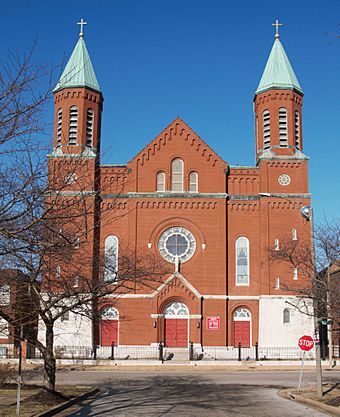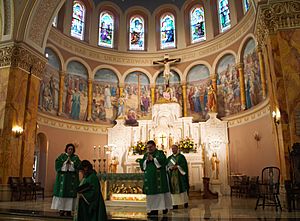St. Stanislaus Kostka Church (St. Louis, Missouri) facts for kids
Quick facts for kids |
|
|
St. Stanislaus Kostka Church
|
|

Eastern exterior front of the church in 2020
|
|
| Location | 1413 North 20th Street, St. Louis, Missouri |
|---|---|
| Built | 1891 |
| Architect | Wessbecher & Hummel |
| Website | St. Stanislaus Parish |
| NRHP reference No. | 79003635 |
| Added to NRHP | July 10, 1979 |
St. Stanislaus Kostka Church is a special church located in St. Louis, Missouri. It is an independent Catholic church, which means it runs itself and is not part of the main Catholic Church organization. It was first built in 1880 to serve the Polish community in St. Louis. Today, the church is managed by its members as a non-profit group.
The church building is famous for its beautiful and grand design. It is considered one of the best examples of the Polish Cathedral style of architecture west of the Mississippi River.
The church is also known for a big disagreement it had with the Archdiocese of St. Louis. This disagreement was about who should control the church and its money. In 2005, the Archbishop of St. Louis made a decision about the church's leaders and priest. The church and the archdiocese worked out their differences in 2013.
Contents
History of the Church
In 1878, the Catholic Church in St. Louis decided to build a new church. This church was meant for the growing number of Polish Catholic families in the city. Before this, Polish families went to St. Patrick's Church. In 1880, construction began on St. Stanislaus Kostka. The church was built in a neighborhood north of Downtown St. Louis, where many Polish immigrants lived.
Early Years and Growth
The first church building was designed in the Romanesque Revival style. It was managed by the Franciscans, a group of priests. St. Stanislaus Kostka became the main church for three other Polish parishes: St. Casimir (built in 1889), St. Hedwig (1904), and Our Lady of Czestochowa (1907).
In 1891, a special document was signed by Archbishop Peter Kenrick. This document said that the church property would be managed by a group of leaders, including a pastor and other members. These leaders were to be chosen by the archbishop. This document is known as the Deed and Charter & Bylaws of 1891. A new, larger church building was designed by Wessbecher and Hummel and opened in September 1892.
Changes and Recognition
In 1928, a fire damaged the church. The fire destroyed the center dome and most of the beautiful decorations inside. The dome was never rebuilt. In 1969, Cardinal Karol Wojtyla, who later became Pope John Paul II, visited the church.
The church building was recognized as a City Landmark in 1976. It was then added to the National Register of Historic Places in 1979. The church is located near where a large housing complex, called Pruitt–Igoe, used to be.
Even as Polish families moved away from the neighborhood, the church continued to serve the Polish community in St. Louis. By the 1950s, most of its local members had moved. However, it still received support from people of Polish heritage. By the 1970s, the church buildings were getting old and needed repairs. The church members started a big project to restore the church building. They also bought land around the church. Later, they built a Polish Heritage Center. By 2005, the church owned about 8 acres (32,000 m2) of land. The church leaders estimated that all the church's property was worth about $9.5 million.
Disagreement with the Archdiocese
A big disagreement happened between the church and the Archdiocese of St. Louis. This argument was about who should control the church's property and money. It was also about who had the final say in how the church was run. The main question was whether the church's property should be controlled by a priest chosen by the archbishop, or by a group of church members. This practice of members controlling church property is called trusteeism.
Start of the Conflict
The disagreement started a long time ago, under Cardinal John J. Glennon. It continued through several archbishops, including Cardinal Joseph Ritter and Archbishop Raymond Leo Burke. The church leaders believed that the archbishop wanted to take control of the church's money and property. They pointed out that the church had fixed itself up without any money from the Archdiocese. They worried that the archbishop planned to close the church once he had control.
The archdiocese, on the other hand, said that the church's board of directors had changed the original rules from 1891. They claimed this happened in the early 1980s without permission. The original rules said that the board should only advise the pastor, who was under the archbishop. The archdiocese said the changed rules gave the board full control of the church. Because of this, Archbishop Burke asked the church to follow the standard rules for Catholic churches in the United States. The church board appealed this decision, but their appeal was not accepted.
The court decided that St. Stanislaus owned its property. It also said the church had the right to make its own rules that limit the archbishop's power.
Actions Taken
In August 2004, Archbishop Burke removed both priests from the church. He moved the Polish ministry to another church. When the priests left, they took church items like hymnals and records. In January 2005, Burke warned the church board members. He said they would face a church penalty if they did not follow his instructions. When they did not comply, he issued a penalty against them. He stated they had "knowingly, deliberately and publicly damaged seriously the unity of the Church."
In February 2005, Burke changed the official church for Polish Catholics in St. Louis to St. Agatha Church. This change was completed in July 2005.
In December 2005, the church board announced they would hire a new priest, Rev. Marek B. Bozek. His own bishop suspended him for leaving his post without permission. In response, Archbishop Burke declared that Bozek and the church board members were guilty of a serious church offense called schism. This offense automatically meant they were no longer part of the Roman Catholic Church. Burke also said he planned to close the parish. Despite this, many people attended the first Mass with the new pastor on Christmas Eve 2005. On December 29, 2005, Burke officially closed St. Stanislaus Kostka Parish because it was operating independently.
In 2008, a Vatican group confirmed the decision to remove the board members from the church. In 2009, Pope Benedict XVI removed Bozek from being a priest. Bozek returned to Poland in June 2022.
Later Events
On July 23, 2008, the Archdiocese of St. Louis announced that some former board members had made peace with the Catholic Church. They were again fully part of the Roman Catholic Church. These members then joined a lawsuit against the St. Stanislaus Parish Corporation. They wanted the corporation to follow the original 1891 rules. If they won, the Archdiocese was ready to appoint a Catholic priest to St. Stanislaus.
In 2010, the archdiocese offered to settle the lawsuit. This offer would have let the church keep its property and money. However, it would have brought the church back under the archdiocese's control. There was no promise the church would not be closed later. The priest, Marek Bozek, would have had to leave. The church members voted on the offer, but it was rejected.
Under Bozek's leadership, the church grew by about 500 families. This happened even though about 200 families had left since the disagreement began. Bozek had some different ideas, like allowing priests to marry. These ideas caused some traditional members to leave but attracted new people.
On March 15, 2012, a St. Louis court judge ruled that the church's property and money belonged to the St. Stanislaus Parish Corporation, not the archdiocese. The judge wrote that "The archbishop may own the souls of wayward St. Stanislaus parishioners, but the St. Stanislaus Parish Corporation owns its own property."
On February 13, 2013, St. Stanislaus Corporation and the Archdiocese of St. Louis announced they had settled their legal disagreement. The archdiocese dropped its appeal, and the court's decision became final. St. Stanislaus agreed not to say it was connected to the Archdiocese of St. Louis or the Roman Catholic Church. Neither side paid money to the other. They hoped ending the legal fight would help everyone heal.
In August 2013, Bishop Wayne Smith of the Episcopal Diocese of Missouri announced that his diocese and St. Stanislaus were talking. They were discussing if St. Stanislaus might join the Episcopal Church (United States). The church was also talking with the Polish National Catholic Church and other groups about possibly joining them.
In August 2019, the Episcopal News Service reported that St. Stanislaus had decided not to officially join the Episcopal Diocese of Missouri. The church's property rights were a key reason for this decision. However, the church did host the ordination of the 11th bishop of the Episcopal Diocese of Missouri in April 2020. The church was chosen for its size, easy access, and welcoming nature.
See also
- Franciscan Sisters of Our Lady of Perpetual Help
- Polish Cathedral style churches


